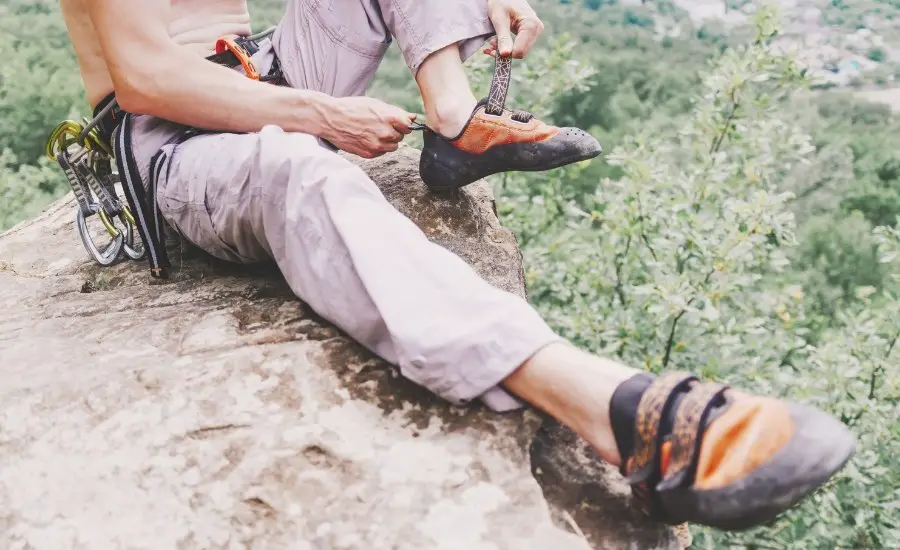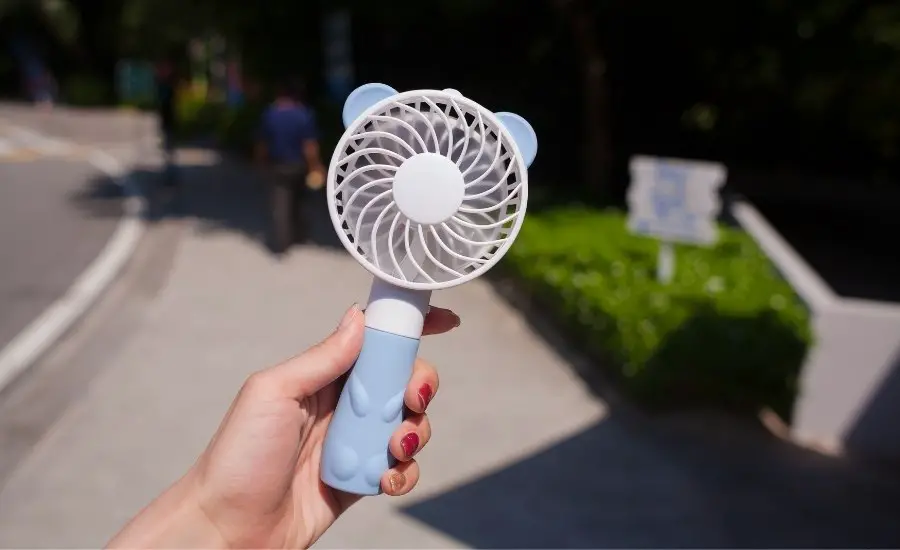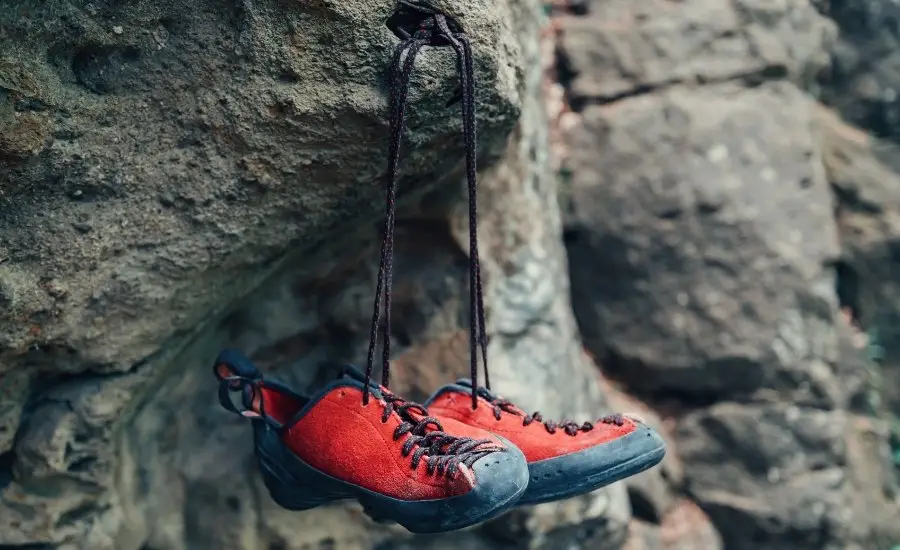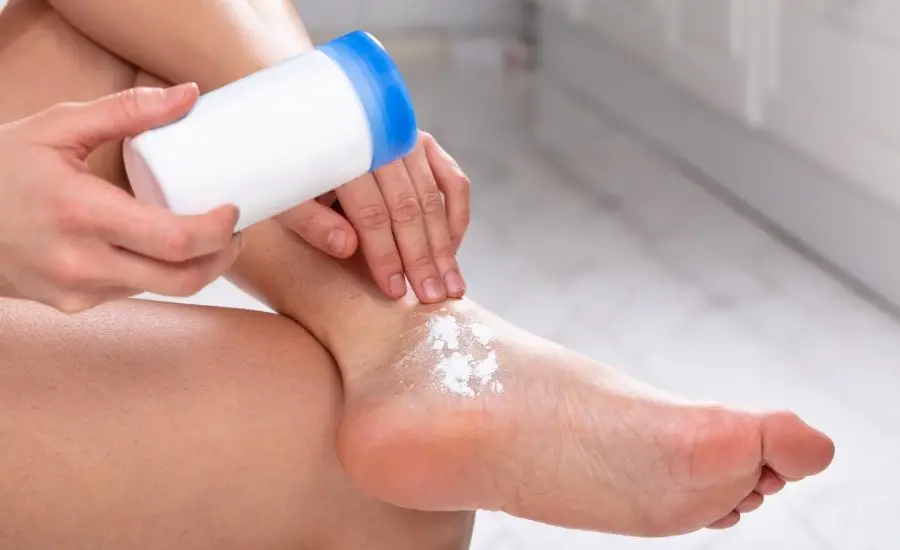Like with any other shoe, climbing shoes are subjected to sweaty feet every-time they are put on. Unlike other shoes however, most climbers wear their shoes without any socks. Luckily enough, there are certain ways to combat them from getting too sweaty.
Here are 10 simple tips to stop sweating so much in climbing shoes:
1. Change Your Climbing Shoes

I have found that certain climbing shoes are better at handling sweaty feet than others. If you have tried other tips on the list already, it may be time for you to think about changing your shoes. Some climbers just have naturally sweaty feet and need all the help they can get.
The best climbing shoes for sweaty feet are the Black Diamond Momentum for beginners and the Black Diamond Zone for intermediate and advanced climbers. Both of these shoes are extremely breathable and decrease the amount of sweat produced by a climber’s feet.
You may have noticed that both of these shoes are made by Black Diamond and that is no coincidence. These shoes are made with Black Diamond’s Engineered Knit Technology. The shoe fabric was specially engineered to be extremely breathable while providing the necessary structure to minimize unwanted stretch.
You can check out the shoes and their current price on Amazon (affiliate links below):
2. Remove Your Shoes Between Attempts
I believe this is by far the most useful tip of the list. Not only your feet will be uncomfortable if you leave your shoes on for the entire session, but your feet will be drenched in sweat.
Taking off your shoes between attempts will give your feet a much needed breather. This will allow them to get out of the confines of your tight climbing shoes and give them chance to air out. Airing them out will allow them to cool down and dry off.
Doing this between every attempt will dramatically reduce the amount of foot sweat you get.
3. Bring a Portable Fan or Towel

This tip is in conjunction with the previous one. It will be beneficial to not only air out your feet, but actively dry them between attempts.
To speed up the drying process, I recommend using a small towel or portable fan. I prefer using a small fan for two reasons:
- You will not have to wash it afterward like you would a towel
- It feels better on your feet
Bonus Tip: Don’t position the fan such that it blows directly towards your feet and then your face. If you do, you will be graced with the less than pleasant smell of your own sweaty feet. Hit them at an angle.
4. Apply Foot Antiperspirant
Foot antiperspirant is different than your typical deodorant stick. It is specially designed to be applied to feet, do not go rubbing your armpit deodorant stick on your feet like a maniac.
Applying these special antiperspirants to your feet before your climbing session will help minimize the amount of sweat that builds up. I recommend using a lotion or a spray variety as it is easy to apply and will likely not build up and make a mess in your climbing shoes.
My favorite foot antiperspirant I have found has been the Carpe Antiperspirant Foot Lotion as seen on Amazon linked here. If you do not want a lotion or spray, antiperspirant powders can be used instead. However, I do not recommend using powders because if you apply too much it may build up in you climbing shoes and create a mess.
5. Completely Dry the Shoes Before Their Next Use
Your sweaty foot probably can be exacerbated if you do not allow your climbing shoes to fully dry before your next session. Keeping them in a sweaty gym bag or the hot trunk of your car will not allow them to dry properly. Starting in already damp climbing shoes will cause your feet to sweat even sooner.

Fully drying out your climbing shoes before your next session is key to keep your feet dry as long as possible. To completely dry them out, I recommend hanging them up and letting them air out or setting them under a fan for an extended period of time.
6. Wear Thin Socks
While wearing socks with climbing shoes in the climbing community is controversial and sometimes frowned upon, it does have its benefits.
Thin socks will help wick away the sweat produced by your feet and will keep them drier than if they were barefoot. I recommend getting lighter socks made out of moisture-wicking fabric. Normal cotton socks will only do some good before they become soaked and cause more problems than before.
Note: wearing socks with climbing shoes may change how your shoes fit and may cause issues. The only way to know however is to try it and see how it feels. If you lose confidence in your feet, socks may not be the way to go. Only do what you feel is safe and comfortable.
7. Apply Cornstarch or Baby Powder to Your Feet

Cornstarch and baby powder can be used as a substitute for special foot antiperspirants (mentioned as tip #4) to reduce sweating as well. They just will not work quite as well and will be more likely to build up and create a mess in your climbing shoes.
8. Stay Hydrated
According to this article written by Medical News Today, staying hydrated will help your body stay cool and reduce sweat production. This happens because drinking water helps regulate your body’s temperature. While this may not target your feet in particular, it will reduce the amount of sweat you produce overall.
By reducing the amount of sweat overall, you will reduce the amount of sweat produced by your feet as well.
9. Keep Yourself Cool
Similar to tip #8 above, keeping yourself cool will reduce the total amount of sweat your body produces and in turn the amount of foot sweat you get. According to this article written by Healthline, loose fitting clothing made from natural fabrics will help your body regulate its temperature and reduce how much you sweat.
In addition to this, the article recommended to stay in cool and comfortable environments. While we cannot dictate the temperature of the climbing gym or nature, you can take action to find cooler places. If you are outside you can find a shady spot and take a rest there. If you are in an indoor gym, try to find a fan or vent and cool off by it.
10. Limit Alcohol and Spicy Food Consumption

As a spicy food lover and enjoyer of alcoholic beverages, this is my least favorite option. I would gladly take sweaty climbing feet over having to stop eating spicy food or drinking my favorite beer.
According to this article by WebMD, both spicy foods and alcohol cause the body to sweat. As I mentioned in the two tips above, the overall amount you sweat will affect how sweaty your feet get as well. Anyone who has tried to climb hungover or after eating spicy Indian food can attest that their session was a sweaty mess.
If you choose to take this route, you are braver than I. I must add, the same WebMD article mentioned that caffeine intake (coffee, tea, etc.) also induces sweating …. but in my good conscious I could never tell anyone to skip their morning coffee. I believe it would do more harm than good.
